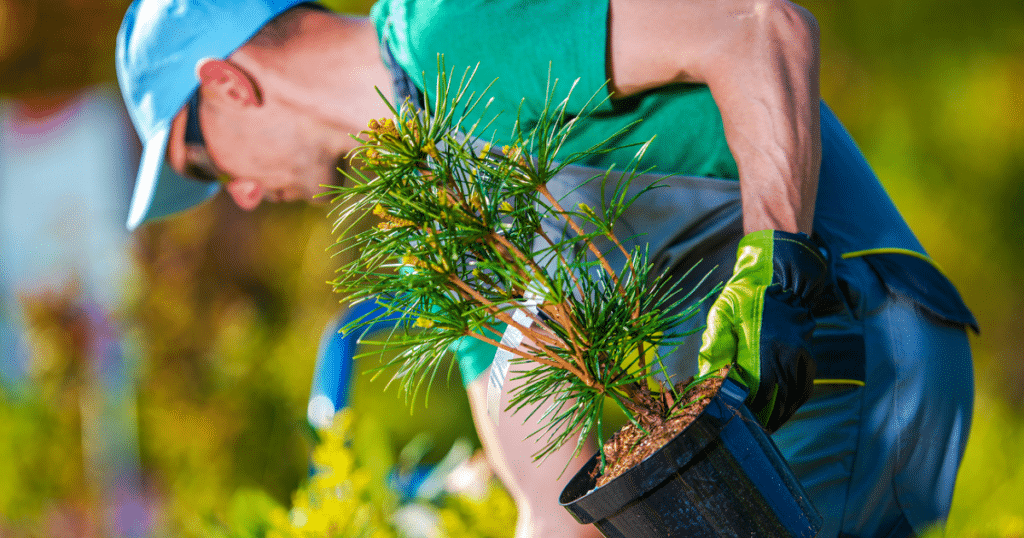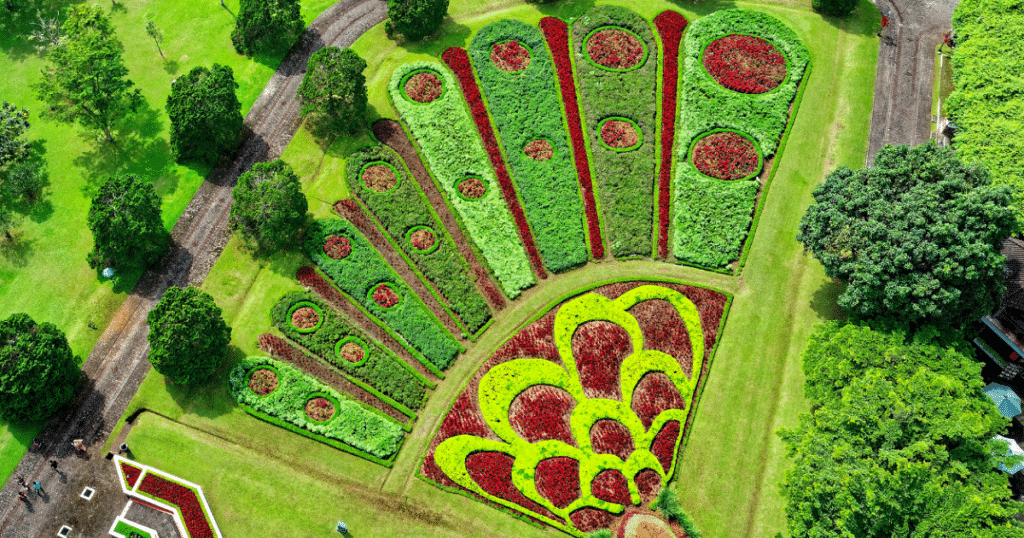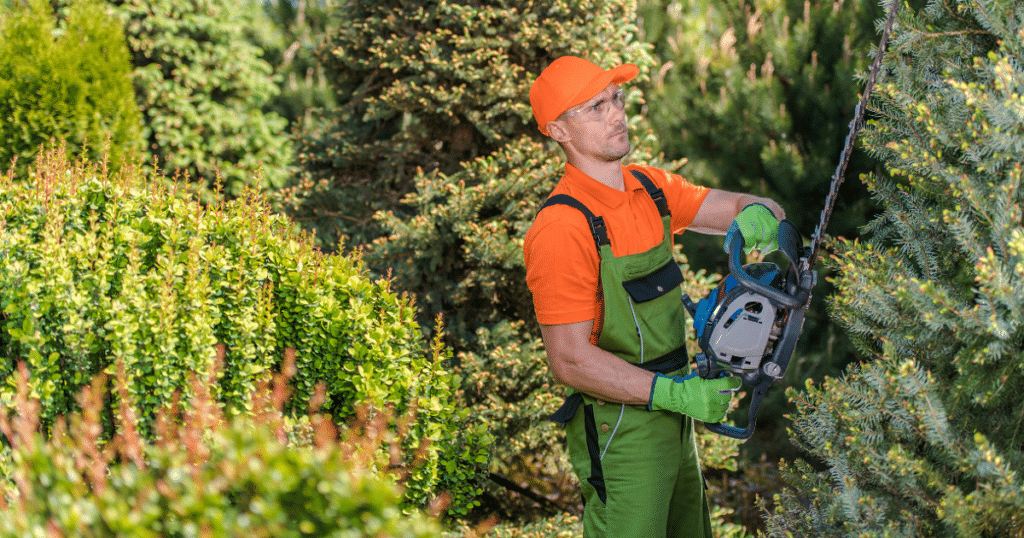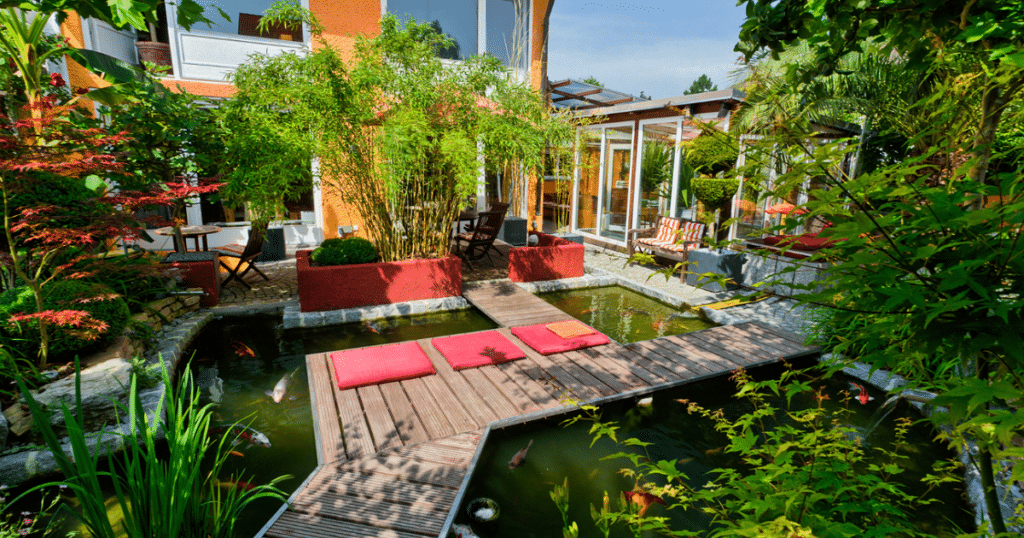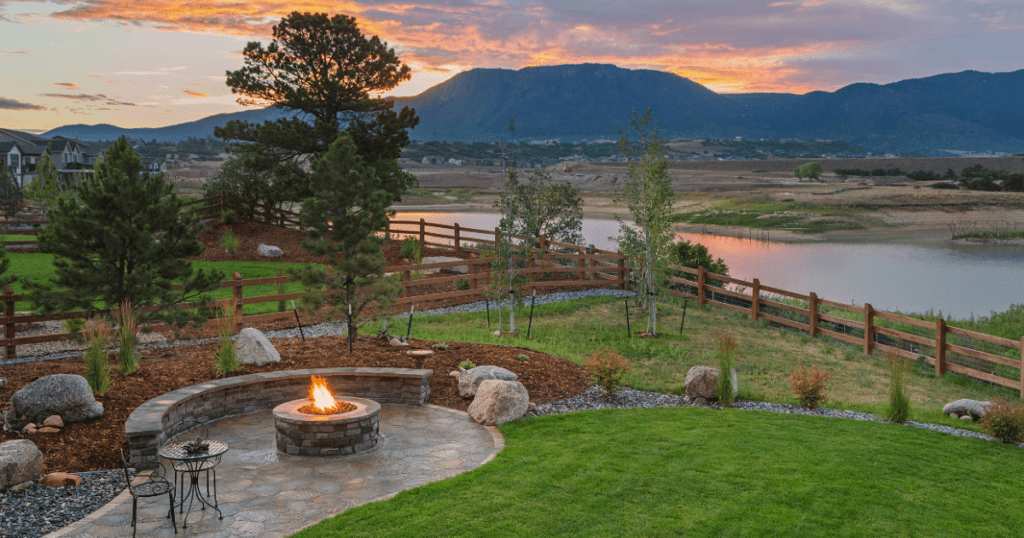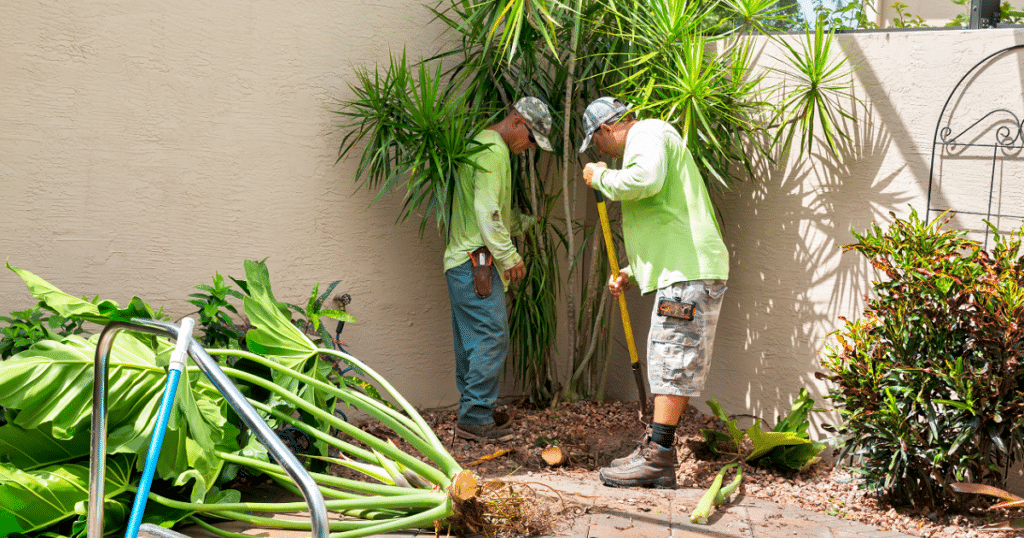
What is a Landscaper?
A landscaper is a professional who designs, installs and maintains outdoor spaces such as gardens, lawns, and other landscape features. They are responsible for evaluating the land’s soil type, climate zone, and sunlight exposure to choose plants that will thrive in the area.
A landscaper’s job also includes installing irrigation systems or creating drainage solutions to ensure that the landscape remains healthy. Moreover, landscapers can design outdoor living spaces and structures such as patios or decks.
The Importance of Landscapers in Texas
Landscaping is crucial for Texans because it serves multiple purposes. First and foremost, it adds value to your property by increasing its visual appeal. Additionally, well-designed landscaping can serve as a functional space where families can gather for outdoor activities or entertain guests.
Texas landscapes are unique compared to other states due to the extreme heat and drought conditions experienced throughout much of the year. This makes landscaping especially challenging since many plant species do not thrive in Texas’s climate zone.
As such, hiring a professional landscaper who understands which plants are native to Texas or drought-tolerant is essential. Despite these challenges, landscaping remains an essential aspect of any Texas property, given its potential impact on water conservation efforts statewide.
According to EPA estimates, residential outdoor water use accounts for more than 9 billion gallons per day during peak summer months – nearly one-third of daily total water consumption in many urban areas across Texas. Therefore it becomes critical for anyone planning landscaping projects on their property to consult with professionals trained on how best practices can maximize water conservation during both the installation and maintenance phases.
Overview of the Landscaping Industry in Texas
The landscaping industry has grown steadily over the years due to increased demand from homeowners seeking modern outdoor living spaces that require low maintenance. The industry’s growth has led to an increase in the number of landscapers and landscaping companies operating across Texas.
Landscapers can provide a broad range of services, including landscape design, installation, and maintenance. Landscape design and build services refer to a process where the landscaper works with clients from conception to completion of outdoor projects.
On the other hand, landscape maintenance entails activities such as pruning plants, watering lawns or gardens, fertilizing plants, and managing pests. Whether you’re looking for landscape design or installation services or want ongoing landscape maintenance support, there are plenty of providers throughout Texas that can help you create a space that is both beautiful and functional while also conserving water resources.
The Role of a Landscaper in Texas
Designing and Implementing Outdoor Spaces that are Functional and Aesthetically Pleasing
A skilled landscaper can transform any outdoor area into a beautiful, functional space that enhances the overall look of the property. The process begins with an initial consultation where the landscaper will discuss with the client their vision, goals, and budget for their landscaping project.
From there, they will create a design plan that takes into account the layout of the property, natural features like trees or hillsides, and any existing structures. Once a design has been agreed upon by both the client and landscaper, installation can begin.
This involves preparing the soil for planting, selecting appropriate plants based on their sun/shade preferences and water requirements, and incorporating hardscaping elements like patios or retaining walls. A skilled landscaper will ensure that each element of the design is installed correctly to ensure maximum functionality and aesthetic appeal.
Choosing Appropriate Plants, Trees, and Shrubs for the Texas Climate
Texas has a unique climate with hot summers and unpredictable rainfall patterns. A knowledgeable landscaper understands which plants are most suitable for this environment to ensure optimal growth while minimizing maintenance requirements. Native Texas plants are often favored for their ability to withstand extreme temperatures while requiring little water.
In addition to choosing suitable plants based on climate, it is important to consider other factors, such as soil type and sun exposure, when selecting greenery for landscaping projects. A good landscaper will take all these factors into account when creating a planting plan to ensure long-term success.
Incorporating Hardscaping Elements such as Patios, Walkways, and Retaining Walls
Hardscaping elements such as patios or walkways can add both visual interest as well as functionality to an outdoor space. When designing these features in Texas landscapes, it is important to consider how they will stand up to the extreme weather that can be common in the area.
For example, using materials like concrete or natural stone that are durable and able to withstand high temperatures is often a wise choice. Retaining walls are another popular hardscaping feature in Texas landscaping projects.
These walls help prevent soil erosion and can add an interesting dimension to a landscape design. A skilled landscaper understands how to properly construct retaining walls while ensuring that they blend seamlessly into the overall look of the property.
Maintaining Landscapes Through Regular Pruning, Watering, Fertilizing, and Pest Control
Proper landscape maintenance is key to ensuring that a landscaping project continues to look beautiful for years to come. This includes regular pruning of trees and shrubs, watering plants appropriately based on their needs, fertilizing as needed for optimal growth, and controlling pests naturally without damaging the environment. A skilled landscaper will work with clients to develop an ongoing maintenance plan tailored specifically for their outdoor space.
This may include regular visits from a professional landscaper or providing guidance on self-maintenance tasks if desired. The goal is always the same – keeping your Texas landscape looking beautiful while minimizing maintenance requirements as much as possible.
RELATED: Professional Fort Worth Landscaper Services: Enhancing Fort Worth’s Beauty and Value
Popular Landscaping Styles in Texas
Hill Country Style – Incorporating Native Plants such as Yucca, Agave, and Cacti
Texas is home to several different regions that offer unique landscapes and climates. One popular style of landscaping in Texas is Hill Country Style.
This style focuses on incorporating native Texas plants that are well-suited to the region’s rocky terrain and semi-arid climate. This includes plants such as yucca, agave, and various species of cacti.
Hill Country Style landscaping often incorporates natural elements like boulders and stones to complement the plant life. Hill Country Style landscaping typically includes low-water-use plants that can thrive in the harsh Texas climate.
Many native Texas plants have adapted to survive in high temperatures with little water, making them ideal for this type of landscape design. Some other popular choices for Hill Country Style landscaping include mountain laurel, Texas sage, and Mexican feather grass.
Landscapers who specialize in Hill Country Style design prioritize sustainability and water conservation. In addition to low-water-use plant selections, they may also incorporate mulch or gravel instead of grass to reduce water usage even further.
Mediterranean Style – Using Drought-Tolerant Plants like Lavender, Rosemary, and Olive Trees
Another popular landscaping style in Texas is Mediterranean Style. This design features drought-tolerant plants commonly found in Mediterranean climates around the world.
These plants are well-suited to areas with hot summers and mild winters, like many parts of Texas. Mediterranean-style landscapes often feature aromatic herbs like lavender and rosemary alongside olive trees, succulents, or other drought-tolerant plant varieties for an elegant yet earthy look.
One distinctive feature of this style is the use of terracotta pots or other pottery as accents throughout the landscape, adding a touch of cultural flair. Mediterranean-style landscapes may also incorporate water features like fountains or small ponds to add a tranquil element.
Modern Style – Featuring Clean Lines with Minimalistic Plant Choices like Succulents or Ornamental Grasses
Landscaping trends evolve over time, and one modern style that has gained popularity in recent years is the Modern Style. This design emphasizes clean lines and minimalism.
Modern Style landscapes may include simple plant choices like succulents or ornamental grasses as well as hardscaping elements such as concrete pavers or geometric planters for a sleek look. The use of neutral colors, such as shades of gray, black, and white, add to the contemporary feel of Modern Style design.
Landscapers who specialize in Modern Style design focus on creating outdoor living spaces that are functional yet aesthetically pleasing. They prioritize versatility and may incorporate different elements, such as modular seating for entertaining guests or outdoor kitchens for cooking and dining al fresco.
Overall, Texas Landscapes offer diverse styles unique to the state’s climate and culture. Hiring the right landscaper Texas can transform your outdoor space into an oasis that reflects your personal taste while incorporating sustainable practices that support water conservation in landscaping through innovative irrigation systems that keep your greenery vibrant all year-round while also saving you money on water usage over time.
Niche Subtopics in Landscaping
Xeriscaping: Designing Landscapes that Require Little to No Water Usage
Xeriscaping, a type of landscaping that requires minimal water usage, is becoming increasingly popular among Texans. Due to the state’s hot and dry climate, water conservation in landscaping is crucial. Xeriscaping not only saves water but also reduces maintenance costs and time.
The key to xeriscaping is choosing plants that are drought-tolerant or native to Texas. Some examples of native Texas plants include Blackfoot Daisy, Mexican Feathergrass, and Purple Coneflower.
When designing a xeriscape, it’s essential to consider factors such as soil quality and sun exposure. A landscaper Texas can assess these factors and suggest appropriate plant choices for the space.
In addition to plant selection, other elements of a xeriscape include mulching, using permeable materials for walkways and patios, and incorporating efficient irrigation systems such as drip irrigation. Overall, xeriscaping is an excellent option for those looking to reduce their environmental impact while still enjoying beautiful outdoor living spaces in Texas.
Edible Landscaping: Incorporating Fruits and Vegetables into the Landscape Design
Edible landscaping involves incorporating fruits and vegetables into the design of outdoor living spaces in Texas. It offers many benefits beyond just adding visual appeal; it can also provide fresh produce right from one’s backyard!
Popular fruits for edible landscaping include citrus trees like oranges or lemons, while vegetable options could be tomatoes or peppers. A landscaper Texas can help design an edible landscape that maximizes space utilization while maintaining aesthetic appeal by selecting varieties that complement each other visually as well as in terms of harvest seasonality.
Additionally, they can assist with the installation of irrigation systems to ensure optimal growing conditions, thus minimizing water use while still yielding a bountiful harvest. Overall, incorporating edible landscaping into outdoor living spaces in Texas can provide visual appeal and nutritional benefits while also promoting sustainable practices such as water conservation in landscaping.
Wildlife-Friendly Landscaping: Creating Habitats for Birds or Butterflies by Planting Specific Flowers or Shrubs
Creating habitats for wildlife-friendly landscaping is a great way to enjoy outdoor living spaces in Texas while also bringing nature closer to home. For example, planting specific flowers and shrubs like milkweed plants or butterfly weed can attract monarch butterflies and their larvae.
Similarly, providing birdhouses or bird feeders can attract various species of birds to the area. A landscaper Texas can help design a wildlife-friendly landscape that maximizes space utilization while considering factors such as sun exposure and soil quality to promote the healthy growth of native plants.
Additionally, they can install efficient irrigation systems that minimize water usage while still ensuring optimal growing conditions for the plantings. Incorporating wildlife-friendly landscaping into outdoor living spaces in Texas not only adds visual appeal but also promotes sustainable practices such as water conservation in landscaping.
RELATED: Landscaper Fort Worth TX: Enhancing the Beauty of Your Property with Professional Services
Rarely Known Small Details about Landscapers in Texas
The Importance of Understanding Soil Types When Choosing Plants
When it comes to choosing the right plants for a landscaping project, it is essential to consider the soil type. The soil composition can impact the growth and health of plants and ultimately affect the overall appearance of the landscape. In Texas, soils range from clay to sand to loamy, with variations in each region.
Clay soils are common in East Texas, while sandy soils dominate West Texas. Loamy soils that are rich in organic matter are found near rivers and streams throughout the state.
Each soil type has unique characteristics that affect plant growth. For instance, clay soils tend to retain water longer than sandy soils, which drain quickly.
This means that clay soil may be better suited for drought-tolerant plants, while sandy soil may require more frequent irrigation. Understanding soil types also helps landscapers determine what amendments or fertilizers might be needed to improve plant health and growth.
For example, if a landscape project requires planting native Texas plants such as Bluebonnets or Indian Paintbrushes, which thrive best on low-nutrient, well-draining soils. Landscapers might choose a light application of slow-release fertilizer or compost to provide needed nutrients without causing overgrowth.
The Significance of Proper Drainage Systems to Prevent Erosion
In Texas landscapes, heavy rainfall can lead to erosion if proper drainage systems are not installed properly or not installed at all. Erosion can lead to exposed tree roots, and flooding damages property quickly, leading it into disrepair and costing homeowners thousands of dollars in repairs.
Landscapers must evaluate drainage needs before starting construction projects since it’s much easier and cost-effective during this phase rather than after installation is complete when changes might need costly excavation projects. One solution is installing French Drains, which direct water away from high-traffic areas like patios or outdoor living spaces.
Another option is creating dry river beds to divert water flowing on sloping landscapes. This solution not only prevents erosion but also creates a visually appealing and unique feature in the landscape.
The Use of Sustainable Practices Such As Composting or Rainwater Harvesting
Water conservation in landscaping is critical, and implementing sustainable practices such as composting or rainwater harvesting can help prevent unnecessary waste and reduce water usage. Composting involves using biodegradable materials such as leaves, grass clippings, and kitchen scraps to create organic matter that improves soil health while reducing waste.
The resulting compost adds nutrients to the soil, thus minimizing fertilizer application to plants. Composting reduces landfill waste which is beneficial in the long term since decomposing materials produce methane gas which can contribute to environmental pollution, causing negative impacts on our planet.
Rainwater harvesting processes involve capturing rainfall runoff from roofs or patios, thus reducing stormwater runoff into urban areas where it causes flooding issues. Rain barrels placed under downspouts are commonly used for this practice in Texas landscapes.
Landscapers can also build cisterns underground that store large amounts of rainwater for larger-scale projects like irrigating large lawns or gardens. Implementing sustainable practices into landscaping projects not only benefits the environment but also helps homeowners save money by reducing water usage and ensuring a healthy ecosystem in their outdoor living spaces for years to come.
Landscaping may seem like an easy task at first glance, but there are plenty of considerations made by landscapers when designing and implementing outdoor living spaces. Multiple factors, consider as soil type, drainage systems, sustainability practices such as composting, and native plants irrigation systems, among others, enable successful project completion. Maintaining these outdoor living spaces through regular pruning, watering, fertilizing, and pest control ensures their beauty lasts for many years ahead- often providing an oasis against the harsh Texas climate.
Frequently Asked Questions
How much does landscaping cost in Texas?
The cost of landscaping in Texas can vary significantly depending on factors such as the size of the project, the complexity of the design, the materials used, and the specific services required. It is recommended to obtain quotes from local landscaping companies in Texas to get accurate pricing information for your specific project.
Does a landscaper need a license in Texas?
In Texas, landscapers may need to obtain a license depending on the scope of their work. Landscape architects, for example, are required to be licensed in Texas. However, specific licensing requirements may vary, so it is advisable to check with the Texas Commission on Environmental Quality or the Texas Department of Licensing and Regulation for detailed information.
What do I need to start a landscaping business in Texas?
To start a landscaping business in Texas, you will typically need to take several steps, including registering your business entity with the Texas Secretary of State, obtaining any required licenses or certifications, such as a pesticide applicator license if you plan to use pesticides, and acquiring necessary insurance coverage. It is also important to familiarize yourself with local zoning and permit requirements.
Do landscapers charge sales tax in Texas?
Landscapers in Texas are generally required to charge sales tax on their services. However, the specifics may vary depending on the type of service provided and local tax regulations. It is advisable to consult with a tax professional or the Texas Comptroller of Public Accounts to ensure compliance with sales tax obligations.
What do landscapers do?
Landscapers perform a range of tasks related to designing, installing, and maintaining outdoor spaces. They may engage in activities such as lawn mowing, planting and caring for trees and plants, installing irrigation systems, constructing hardscapes like patios and walkways, and providing general landscape maintenance services like fertilizing and weed control.
How much do landscapers make a year in Texas?
The annual income of landscapers in Texas can vary depending on factors such as experience, qualifications, the size of their business, and the demand for their services. On average, landscapers in Texas earn around $30,000 to $50,000 per year, but this can vary significantly based on individual circumstances and market conditions.
Conclusion
Summary of the Importance of Landscapers in Texas
Landscapers play an essential role in Texas landscapes, from designing and constructing outdoor living spaces to maintaining them. They work with native Texas plants, drought-tolerant landscaping, and water conservation to create functional and beautiful landscapes that thrive in the harsh Texan climate.
Native plants are an integral part of Texas landscapes. They are well adapted to the local climate, and because they are accustomed to native pests and diseases, they require less maintenance.
Landscapers who work with native Texas plants can design landscapes that not only look great but also reduce water consumption since these plants do not need as much watering as non-native ones. Landscape maintenance is another crucial aspect that landscapers handle.
Regular pruning, fertilizing, pest control, and irrigation ensure that any outdoor living space remains healthy all year round. Professional landscapers use sustainable practices such as composting or rainwater harvesting to help conserve water resources while creating stunning outdoor living spaces.
Final Thoughts on the Diverse Landscape Industry in Texas
The landscape industry in Texas is diverse and ever-evolving. Landscaping companies offer a range of services from landscape design and build to irrigation systems installation. With many different styles to choose from, like Hill Country Style or Mediterranean Style, landscapers can create unique designs for each client’s individual needs.
Landscaping in Texas has come a long way over the years, with people becoming more aware of water conservation when it comes to their outdoor living spaces. Drought-tolerant landscaping is increasing among homeowners who want beautiful yards without sacrificing their water usage or having high monthly bills.
This shift towards eco-friendly practices shows how landscapers’ role has become more important than ever. Landscaper Texas plays an instrumental role in creating beautiful and sustainable outdoor living spaces across Texas while also promoting environmental conservation and water preservation.
Landscapers’ expertise in native plants, landscape design, and construction helps create landscapes that are not only aesthetically pleasing but also functionally efficient. The future of the landscape industry in Texas looks promising, with more homeowners embracing sustainable practices, and landscapers are at the forefront of this exciting trend.


